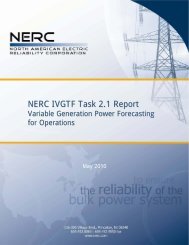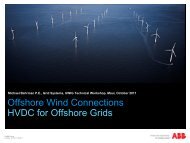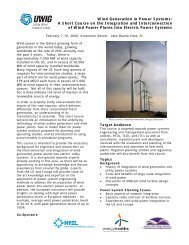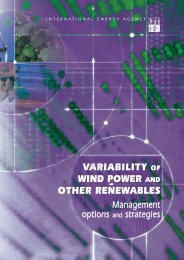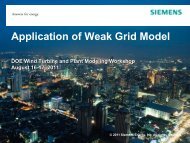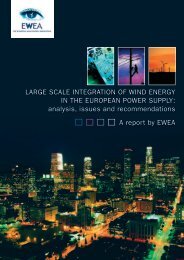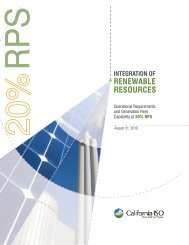Integrating Southwest Power Pool Wind to Southeast Electricity ...
Integrating Southwest Power Pool Wind to Southeast Electricity ...
Integrating Southwest Power Pool Wind to Southeast Electricity ...
You also want an ePaper? Increase the reach of your titles
YUMPU automatically turns print PDFs into web optimized ePapers that Google loves.
Figure 5-20: Capacity Fac<strong>to</strong>rs for SPP by unit type<br />
There is little significant change in capacity fac<strong>to</strong>rs across scenarios for the other SERC regions<br />
across the scenarios. The eastern SERC regions (mainly VACAR) do not change noticeably,<br />
while CCs and <strong>to</strong> a lesser extent coal change in the western regions, as shown earlier. Another<br />
note of significance for those regions is the fact they both have significant GT capacity fac<strong>to</strong>rs,<br />
indicating that they use these units more than the main study regions.<br />
Figure 5-21shows capacity fac<strong>to</strong>rs across the entire footprint. Again, this is similar <strong>to</strong> generation<br />
described earlier. It can be seen that much of the differences again lies in CC usage. There is a<br />
significant decrease in CC usage in Scenarios 3 and 4 in particular, indicating that they may not<br />
all be present in a future plant mix with this much wind. This would be crucial as these units are<br />
shown <strong>to</strong> provide much of the reserve requirements. Alternatively, if it is shown that they are<br />
needed <strong>to</strong> provide reserve, then they may be built, or not retired. This would impact capital cost<br />
recovery, not studied here. Looking at the average CC capacity fac<strong>to</strong>r, 20% still seems relatively<br />
high, though lower than it would be with low wind.<br />
5-27




